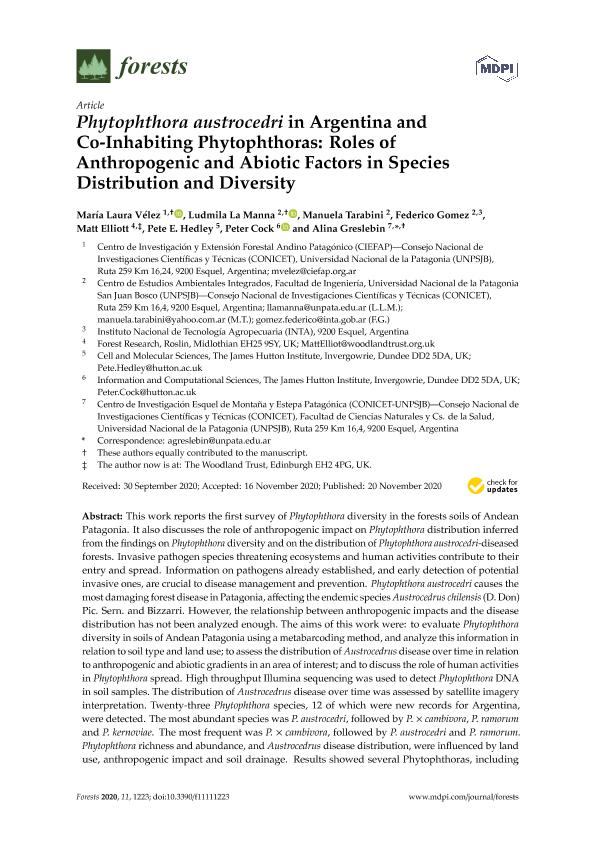Mostrar el registro sencillo del ítem
dc.contributor.author
Vélez, María Laura

dc.contributor.author
la Manna, Ludmila Andrea

dc.contributor.author
Tarabini, Manuela Mabel

dc.contributor.author
Gomez, Federico Antonio

dc.contributor.author
Elliott, Matt
dc.contributor.author
Hedley, Pete E.
dc.contributor.author
Cock, Peter
dc.contributor.author
Greslebin, Alina Gabriela

dc.date.available
2020-12-09T14:02:00Z
dc.date.issued
2020-11
dc.identifier.citation
Vélez, María Laura; la Manna, Ludmila Andrea; Tarabini, Manuela Mabel; Gomez, Federico Antonio; Elliott, Matt; et al.; Phytophthora austrocedri in Argentina and Co-Inhabiting Phytophthoras: Roles of Anthropogenic and Abiotic Factors in Species Distribution and Diversity; MDPI AG; Forests; 11; 11; 11-2020; 1-24
dc.identifier.issn
1999-4907
dc.identifier.uri
http://hdl.handle.net/11336/119949
dc.description.abstract
This work reports the first survey of Phytophthora diversity in the forests soils of Andean Patagonia. It also discusses the role of anthropogenic impact on Phytophthora distribution inferred from the findings on Phytophthora diversity and on the distribution of Phytophthora austrocedri-diseased forests. Invasive pathogen species threatening ecosystems and human activities contribute to their entry and spread. Information on pathogens already established, and early detection of potential invasive ones, are crucial to disease management and prevention. Phytophthora austrocedri causes the most damaging forest disease in Patagonia, affecting the endemic species Austrocedrus chilensis (D. Don) Pic. Sern. and Bizzarri. However, the relationship between anthropogenic impacts and the disease distribution has not been analyzed enough. The aims of this work were: to evaluate Phytophthora diversity in soils of Andean Patagonia using a metabarcoding method, and analyze this information in relation to soil type and land use; to assess the distribution of Austrocedrus disease over time in relation to anthropogenic and abiotic gradients in an area of interest; and to discuss the role of human activities in Phytophthora spread. High throughput Illumina sequencing was used to detect Phytophthora DNA in soil samples. The distribution of Austrocedrus disease over time was assessed by satellite imagery interpretation. Twenty-three Phytophthora species, 12 of which were new records for Argentina, were detected. The most abundant species was P. austrocedri, followed by P. × cambivora, P. ramorum and P. kernoviae. The most frequent was P. × cambivora, followed by P. austrocedri and P. ramorum. Phytophthora richness and abundance, and Austrocedrus disease distribution, were influenced by land use, anthropogenic impact and soil drainage. Results showed several Phytophthoras, including well-known pathogenic species. The threat they could present to Patagonian ecosystems and their relations to human activities are discussed. This study evidenced the need of management measures to control the spread of P. austrocedri and other invasive Phytophthora species in Patagonia.
dc.format
application/pdf
dc.language.iso
eng
dc.publisher
MDPI AG
dc.rights
info:eu-repo/semantics/openAccess
dc.rights.uri
https://creativecommons.org/licenses/by-nc-sa/2.5/ar/
dc.subject
FOREST DISEASES
dc.subject
INVASIVE SPECIES
dc.subject
METABARCODING
dc.subject
RISK MODELS
dc.subject.classification
Micología

dc.subject.classification
Ciencias Biológicas

dc.subject.classification
CIENCIAS NATURALES Y EXACTAS

dc.subject.classification
Ecología

dc.subject.classification
Ciencias Biológicas

dc.subject.classification
CIENCIAS NATURALES Y EXACTAS

dc.subject.classification
Agricultura

dc.subject.classification
Agricultura, Silvicultura y Pesca

dc.subject.classification
CIENCIAS AGRÍCOLAS

dc.title
Phytophthora austrocedri in Argentina and Co-Inhabiting Phytophthoras: Roles of Anthropogenic and Abiotic Factors in Species Distribution and Diversity
dc.type
info:eu-repo/semantics/article
dc.type
info:ar-repo/semantics/artículo
dc.type
info:eu-repo/semantics/publishedVersion
dc.date.updated
2020-12-04T19:53:51Z
dc.journal.volume
11
dc.journal.number
11
dc.journal.pagination
1-24
dc.journal.pais
Suiza

dc.journal.ciudad
Basel
dc.description.fil
Fil: Vélez, María Laura. Centro de Investigación y Extensión Forestal Andino Patagónico; Argentina. Universidad Nacional de la Patagonia "San Juan Bosco"; Argentina
dc.description.fil
Fil: la Manna, Ludmila Andrea. Universidad Nacional de la Patagonia "San Juan Bosco". Facultad de Ingeniería - Sede Esquel; Argentina. Consejo Nacional de Investigaciones Científicas y Técnicas. Centro Científico Tecnológico Conicet - Patagonia Norte; Argentina
dc.description.fil
Fil: Tarabini, Manuela Mabel. Universidad Nacional de la Patagonia "San Juan Bosco". Facultad de Ingeniería - Sede Esquel; Argentina. Consejo Nacional de Investigaciones Científicas y Técnicas. Centro Científico Tecnológico Conicet - Patagonia Norte; Argentina
dc.description.fil
Fil: Gomez, Federico Antonio. Universidad Nacional de la Patagonia "San Juan Bosco". Facultad de Ingeniería - Sede Esquel; Argentina. Instituto Nacional de Tecnología Agropecuaria; Argentina. Consejo Nacional de Investigaciones Científicas y Técnicas. Centro Científico Tecnológico Conicet - Patagonia Norte; Argentina
dc.description.fil
Fil: Elliott, Matt. Forest Research, Roslin,; Reino Unido
dc.description.fil
Fil: Hedley, Pete E.. The James Hutton Institute; Reino Unido
dc.description.fil
Fil: Cock, Peter. The James Hutton Institute; Reino Unido
dc.description.fil
Fil: Greslebin, Alina Gabriela. Consejo Nacional de Investigaciones Científicas y Técnicas. Centro Científico Tecnológico Conicet - Patagonia Norte. Centro de Investigación Esquel de Montaña y Estepa Patagóica. Universidad Nacional de la Patagonia "San Juan Bosco". Facultad de Ciencias Naturales - Sede Esquel. Centro de Investigación Esquel de Montaña y Estepa Patagónica; Argentina
dc.journal.title
Forests
dc.relation.alternativeid
info:eu-repo/semantics/altIdentifier/url/https://www.mdpi.com/1999-4907/11/11/1223
dc.relation.alternativeid
info:eu-repo/semantics/altIdentifier/doi/http://dx.doi.org/10.3390/f11111223
Archivos asociados
